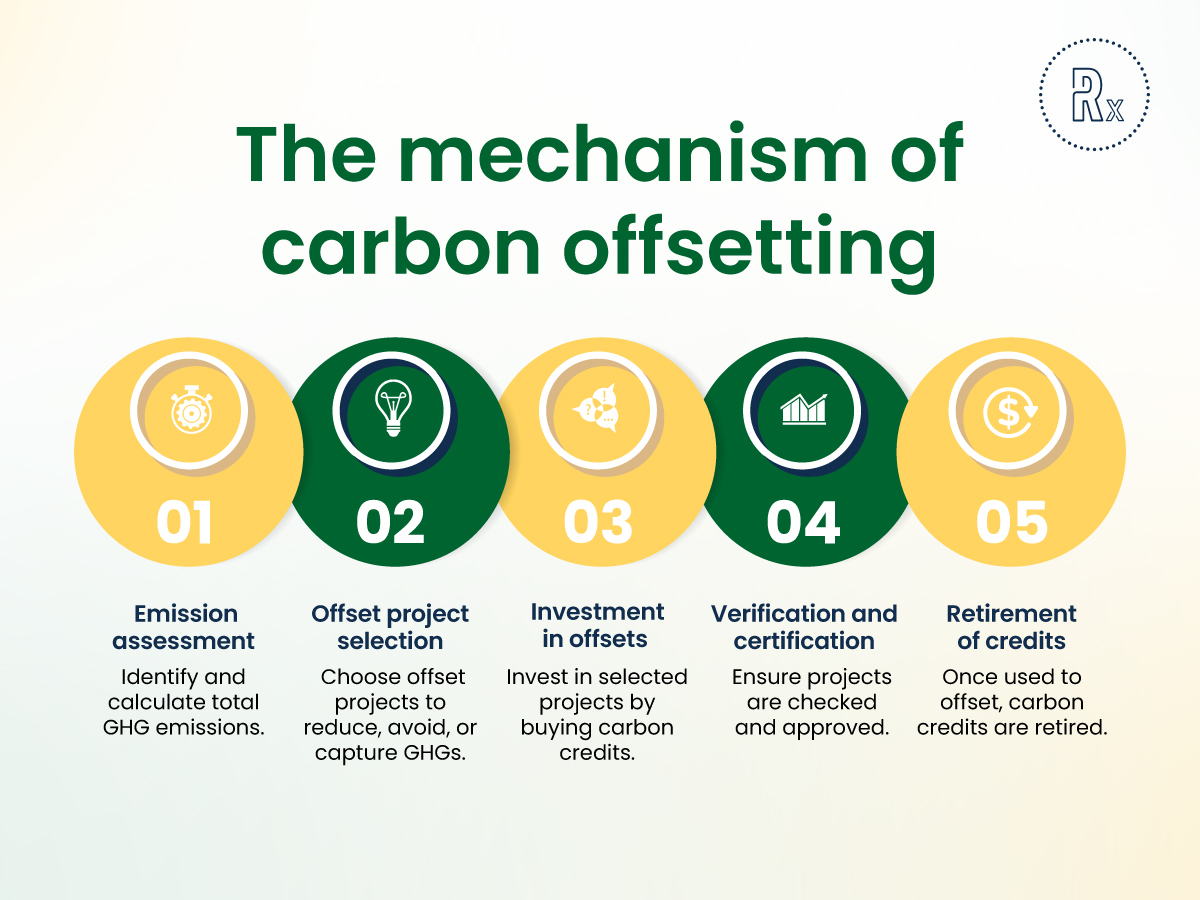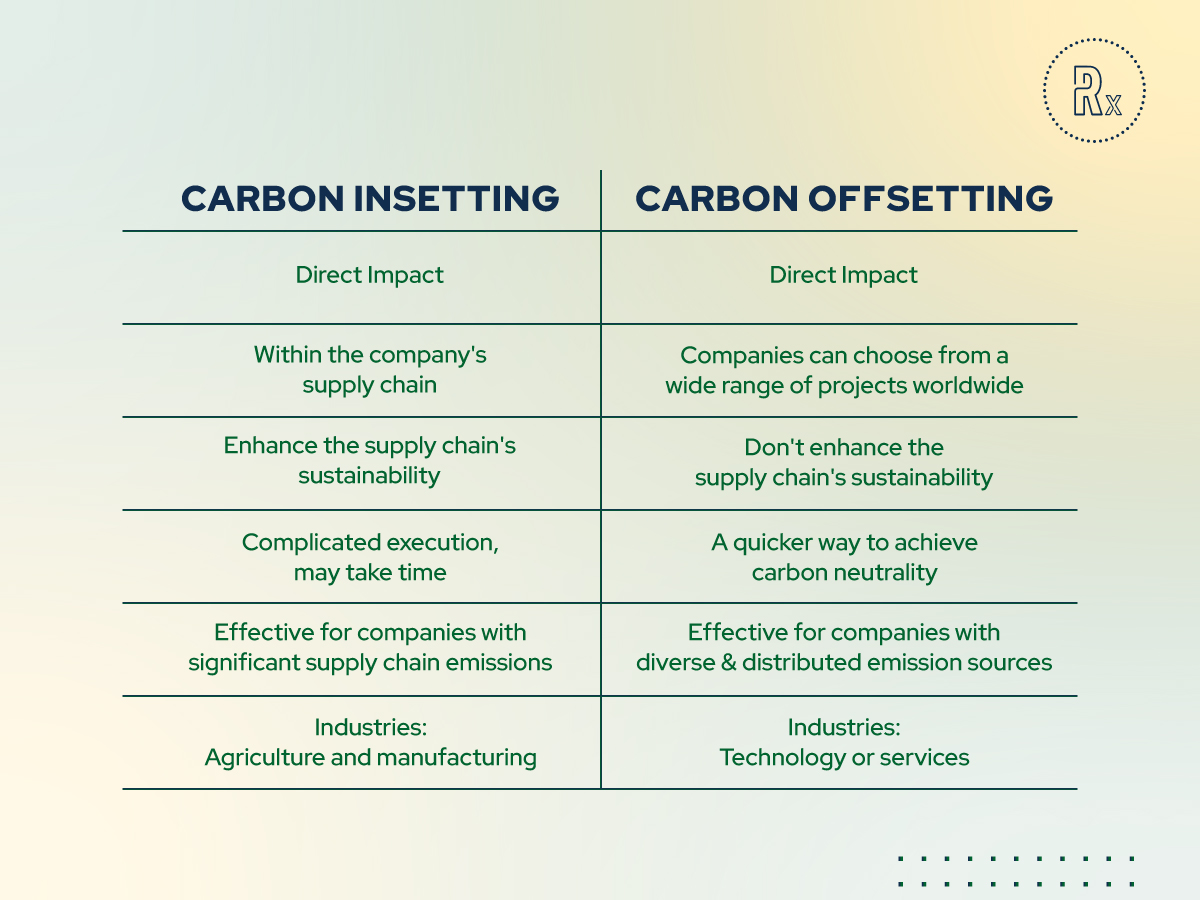To regulate business carbon footprint, the concepts of carbon insetting and offsetting have emerged as the two pillar strategies to drive down a business’s carbon release. These are not just corporate responsibilities in reducing their carbon footprint but also contribute to the global fight against climate change.
If that’s is what you know so far, then the questions remain: How do they differ? Which approach is suitable for your business? And how to to pursued that strategy?
Although carbon insetting and offsetting both aim to cut down on greenhouse gases, they do it in very different ways. Let’s tell them apart.
The concept of carbon offsetting
Definition and explanation
Carbon offsetting is a method employed by individuals and organizations to compensate for their greenhouse gas emissions.
It involves investing in environmental projects that reduce or absorb an equivalent amount of carbon dioxide (CO2) or other greenhouse gases from the atmosphere. Essentially, it’s like evening out the harm done in one place by doing good in another.
Historical context
The concept of carbon offsetting emerged as a response to growing concerns about climate change and the need for effective emission reduction strategies. The practice began in 1989 with Applied Energy Services, which offset its emissions through an agriforest project in Guatemala. This event marked a significant shift in corporate environmental responsibility, setting the precedent for future offsetting initiatives.
Subsequent developments, such as the Kyoto Protocol, EU Emissions Trading Scheme, and Paris Agreement, further shaped and legitimized carbon offsetting as a global climate action tool.
Mechanism of carbon offsetting
Carbon offsetting operates on a principle that allows for the counterbalancing of greenhouse gas emissions through investment in environmental projects. Here’s a closer look at how this mechanism works in practice:
- Emission assessment: The first step in carbon offsetting involves quantifying the emissions produced by a company or individual. This involves calculating the total greenhouse gas emissions resulting from various activities, such as manufacturing processes, transportation, and energy usage.
- Offset project selection: Once the emissions are quantified, the next step is to select appropriate offset projects. These projects are typically managed by third-party organizations and are designed to reduce, avoid, or sequester greenhouse gases.
- Investment in offsets: The entity then invests in the chosen projects in proportion to their emissions. This investment is typically made through the purchase of carbon credits from voluntary carbon markets. Each credit represents a certain amount of greenhouse gas reduction or sequestration, usually measured in metric tons of CO2 equivalent.
- Verification and certification: For a carbon offsetting project to be credible, it must be verified and certified by independent bodies. These organizations ensure that the projects effectively reduce emissions as claimed and adhere to certain standards. They also ensure the principle of “additionality,” meaning that the emission reductions wouldn’t have occurred without the offsetting project.
- Retirement of credits: Once carbon credits are used to offset emissions, they are retired to prevent double counting. This means that each credit can only be used once, ensuring the integrity of the offsetting process.

Carbon offsetting lets companies make up for their environmental impact by helping global efforts to lower greenhouse gases. But it’s important to remember that this doesn’t replace the need to cut down emissions directly.
Examples of carbon offset projects
Common examples of carbon offset projects include:
- Reforestation and afforestation projects that absorb CO2 through tree growth.
- Renewable energy projects, such as wind or solar farms, that reduce reliance on fossil fuels.
- Energy efficiency projects that decrease CO2 emissions by improving industrial or residential energy use.
- Methane capture projects that prevent this potent greenhouse gas from entering the atmosphere.
Critique of carbon offsetting
Despite its potential benefits, carbon offsetting is not without criticism. Key concerns include:
- Questionable effectiveness in significantly reducing climate change.
- Insufficiency of offsets to counterbalance global CO2 emissions.
- Risks of greenwashing, where offsetting creates a false sense of achievement in environmental responsibility.
- Potential adverse impacts on local communities and ecosystems.
- Risks associated with forest-based projects, such as the potential release of sequestered carbon post-project.
Understanding carbon insetting
Carbon insetting stands as a relatively newer concept in the realm of carbon management, representing a more integrated approach to reducing greenhouse gas emissions.
Unlike offsetting, which typically involves external projects, insetting focuses on reducing emissions within a company’s own supply chain and operations.
Definition and explanation
Insetting is when a company puts money into projects that help its own operations and supply chain become more environmentally friendly. These projects aim to lower or capture the harmful gases the company produces.
By looking inside its own operations, insetting allows companies to reduce their environmental harm, make their processes better, and support green practices in their main business activities.
Origin and evolution
The concept of carbon insetting emerged as organizations started recognizing the limitations of external offsetting and sought more holistic ways to address their environmental impact.
Insetting lets companies deal with their pollution directly by making sustainability a part of how they do business, not just by supporting projects elsewhere.
Key features and differentiation
Insetting often involves initiatives like improving energy efficiency, adopting renewable energy sources or implementing regenerative agricultural practices within the supply chain. These efforts not only reduce emissions but also contribute to a more sustainable and resilient business model.
Insetting in action: case studies
Numerous companies have successfully implemented insetting projects. For instance,
Nespresso, a division of Nestlé, has embarked on a significant insetting initiative, planting 10 million trees across Colombia, Guatemala, Ethiopia, Mexico, and Nicaragua. This initiative aims for carbon neutrality by 2020. By planting trees, they offset their emissions, enhance land and ecosystems for farmers, and consequently improve the quality of coffee for consumers.
The initiative also involves collaboration with university-based forestry specialists, soil scientists, and social science researchers, ensuring the selection of native tree species and the involvement of local farmers and communities in the planting process.
Another case is L’Oréal, one of the top global cosmetics brands. The company has engaged in carbon insetting by providing low-carbon cookstoves to a community in Burkina Faso, from where it sources shea butter. This initiative helps to reduce emissions and health hazards associated with traditional cooking methods.
Benefits for businesses and the environment
The advantages of carbon insetting are manifold. For businesses, it leads to a more sustainable and efficient supply chain, potentially reducing costs in the long term. It also aligns the company’s operations with its sustainability goals, enhancing its brand image and stakeholder relations. On the environment side, insetting cuts down greenhouse gases right at the source and helps protect nature and different species.
In summary, carbon insetting offers a proactive and integrative approach to carbon management, allowing companies to directly address their environmental impact.
Comparative analysis: Insetting vs Offsetting
In the pursuit of environmental sustainability and carbon neutrality, both carbon insetting and offsetting offer distinct yet complementary approaches.

Carbon insetting Advantages
Disadvantages
Effectiveness for different entities Carbon Insetting works well for companies that have a lot of emissions from their supply chains and those who really want to make sustainability a big part of their business. It’s also beneficial for companies that want to have better relationships with their suppliers and the communities they work in. Industry-Specific Applications In industries like agriculture and manufacturing, where supply chain emissions are significant, insetting can be a powerful tool. For instance, a food processing company might invest in sustainable agricultural practices among its suppliers. | Carbon offsetting
Carbon Offsetting is helpful for companies wanting quick action on reducing their carbon emissions, especially if their emissions come from many different places far apart. It also complements broader sustainability strategies for businesses at various stages of their sustainability journey. In sectors such as technology or services, where direct emissions are lower but indirect emissions from energy use are high, offsetting through renewable energy projects can be a more viable option. |
In conclusion, the choice between carbon insetting and offsetting is not mutually exclusive. A balanced and strategic combination of both can provide a comprehensive approach to carbon management, aligning with a company’s specific circumstances and sustainability objectives.
Carbon insetting and offsetting with RegenX
Adopting regenerative agriculture and carbon strategies like insetting and offsetting benefits businesses beyond just the environment. It aligns with sustainability goals and stakeholder expectations.
RegenX supports businesses by linking them with regenerative agriculture projects for carbon credits and offers a data dashboard to track sustainability efforts’ impact. Contact us now to learn how we can offset and inset your GHG emissions with regenerative agriculture.



